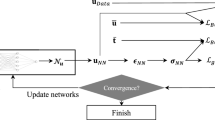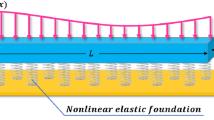Abstract
The probabilistic crack approach, based on the Monte Carlo method, was recently developed for finite element analysis of concrete cracking and related size effects. In this approach the heterogeneity of the material is taken into account by considering the material properties (tensile strength, Young modulus, etc.) to vary spatially following a normal distribution. N samples of the vector of random variables are generated from a specific probability density function, and the N samples corresponding to a simulation are functions of the mean value and of the standard deviation that define the Gauss density function. The problem is that these statistical moments are not known, a priori, for the characteristic volume of the finite elements used in the analysis. The paper proposes an inverse finite element analysis using neural networks for the determination of the statistical distribution parameters (e.g., for a normal distribution, the mean and the standard deviation) from a given response of the structure (for instance, an average load-displacement curve). From FE-analysis of 4-point bending beam tests, it is shown that the backanalysis technique developed in this paper is a powerful tool to determine the probabilistic distribution functions at the material level from structural tests for material volumes which are generally not accessible to direct testing.
Similar content being viewed by others
References
Benitez, J.M., Castro, J.L. and Requena, I. (1997). Are artificial neural networks black boxes? IEEE Transactions on Neural Networks 8(5), 1156–1164.
Bažant, Z.P. (1997). Scaling of the quasi-brittle fracture: asymptotic analysis. International Journal of Fracture 83(1), 19–44.
Fairbairn, E.M.R., Paz, C.N.M., Alvez, J.L.D. and Silva, R.C.C. (1997). Evaluation of constitutive relations for numerical modeling of concrete(in Portuguese). Proceedings of XVIII CILAMCE, Brasilia, Brazil, October 29–31.
Fairbairn, E.M.R., Guedes, Q.M. and Ulm, F.-J. (1998a). An inverse problem analysis for the determination of probabilistic parameters of concrete behavior modeled by a statistical approach. Materials and Structures, RILEM, in press.
Fairbairn, E.M.R., Ebecken, N.F.F., Goulart, E. and Paz, C.N.M. (1998b). Probabilistic modeling of concrete cracking: using neural networks to solve the inverse problem. (Edited by B.H.V. Topping), Advances in Engineering Computational Technology (Int. Conf. August 1998, Edinburgh).
Fairbairn, E.M.R., Ebecken, N.F.F., Goulart, E., Viana, D.M. and Guedes, Q.M. (1999). Durability assessment of an arch dam using inverse analysis with neural networks and high performance computing, abstract accepted to the 13th ASCE Engineering Mechanics Division Conference, to be held in Baltimore, June 13–16.
Hordijk, D.A. (1991). Local approach to fatigue of concrete. Ph.D. Thesis, Technique Universitei Delft, The Netherlands.
Klir, J.J. and Yuan, B. (1995). Fuzzy sets and fuzzy logic — theory and applications. Binghamton.
Press, W.H., Teukolsky, S., Vetterling, W.T. and Flannery, B. (1992). Numerical Recipes, Cambridge University Press.
Rossi, P. and Richer, S. (1987). Numerical modeling of concrete cracking based on a stochastic approach. Materials and Structures, RILEM, 20, 334–337.
Rossi, P., Wu, X., le Maou, F. and Belloc, A. (1994). Scale effect on concrete in tension. Materials and Structures, RILEM, 27, 437–444.
Rossi, P., Ulm, F.-J. and Hachi, F. (1996). Compressive behavior of concrete: physical mechanisms and modeling. Journal of Engineering Mechanics, ASCE, 122(11), 1038–1043.
Rossi, P. and Ulm, F.-J. (1997). Size effects in the biaxial behavior of concrete: physical mechanisms and modeling. Materials and Structures, RILEM, 30, 210–216.
Weibull, W. (1939). A statistical theory of the strength of materials. Proc. Royal Swedish Institute of Engineering Research, 151.
Author information
Authors and Affiliations
Rights and permissions
About this article
Cite this article
Fairbairn, E., Paz, C., Ebecken, N. et al. Use of neural networks for fitting of FE probabilistic scaling model parameters. International Journal of Fracture 95, 315–324 (1999). https://doi.org/10.1023/A:1018677023642
Issue Date:
DOI: https://doi.org/10.1023/A:1018677023642




